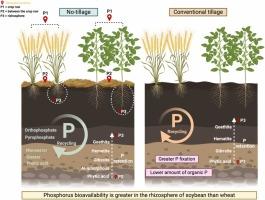Speciation, spatial distribution and bioavailability of phosphorus in a tropical soil cultivated with soybeans and wheat as affected by soil tillage in a long-term field experiment
IF 6.8
1区 农林科学
Q1 SOIL SCIENCE
引用次数: 0
Abstract
Globally, phosphorus (P) is one of the most limiting macronutrients for agricultural production. Humid tropical soils have historically low natural P contents, with most P forming high-binding energy compounds with mineral colloids. No-tillage (NT) systems, where fertilizers are positioned in the furrow, can influence plant nutrient uptake and fertilizer use efficiency. In this study, 31P nuclear magnetic resonance (31P–NMR) and X-ray absorption near-edge structure (XANES) were used to evaluate P species in the soil solid phase and solution, focusing on different positions: crop row, between crop rows, and rhizosphere of soybean [Glycine max (L.) Merr.] and wheat (Triticum spp.) cultivated for 36 years in an Oxisol under NT and conventional tillage (CT, with disc plowing and harrowing). Labile P levels were, on average, 25 % higher in NT compared to CT, mainly due to increases in moderately labile and non-labile fractions (p < 0.05). Total P did not differ between systems, with inorganic P representing 65–69 % of total P. In both crops, P was enriched in the rhizosphere and crop row relative to the between-row position, with orthophosphate accounting for 72–85 % of Na-EDTA-extracted P. XANES and chemical fractionation consistently indicated a predominance of P associated with Fe and Al oxyhydroxides. Additionally, XANES detected phytic acid accumulation in the rhizosphere, suggesting a role for root and microbial processes in shaping organic P dynamics. These results highlight the importance of long-term soil management in enhancing P bioavailability and fertilizer use efficiency in tropical agroecosystems.

土壤耕作对热带大豆和小麦土壤磷形态、空间分布和生物有效性的影响
在全球范围内,磷(P)是农业生产中最受限制的常量营养元素之一。湿润的热带土壤天然磷含量历史上较低,大部分磷与矿物胶体形成高结合能化合物。免耕(NT)系统将肥料放置在犁沟中,可以影响植物的养分吸收和肥料利用效率。本研究采用31P核磁共振(31P - nmr)和x射线吸收近边结构(XANES)对土壤固相和溶液中的磷进行了评价,重点研究了不同位置:作物行、作物行间和大豆根际[Glycine max (L.)]。稳定。]和小麦(Triticum spp)在一个Oxisol中种植了36年,采用NT和传统耕作(CT,圆盘耕作和耙耕)。与CT相比,NT的不稳定P水平平均高出25 %,主要是由于中度不稳定和非不稳定部分的增加(P <; 0.05)。两种作物的总磷没有差异,无机磷占总磷的65-69 %。相对于行间位置,两种作物的根际和作物行都富集磷,正磷酸盐占na - edta提取的P. XANES的72-85 %,化学分选一致表明,与铁和铝氧化物相关的P占优势。此外,XANES检测到根际中植酸的积累,表明根和微生物过程在形成有机磷动力学中的作用。这些结果强调了长期土壤管理对提高热带农业生态系统磷生物有效性和肥料利用效率的重要性。
本文章由计算机程序翻译,如有差异,请以英文原文为准。
求助全文
约1分钟内获得全文
求助全文
来源期刊

Soil & Tillage Research
农林科学-土壤科学
CiteScore
13.00
自引率
6.20%
发文量
266
审稿时长
5 months
期刊介绍:
Soil & Tillage Research examines the physical, chemical and biological changes in the soil caused by tillage and field traffic. Manuscripts will be considered on aspects of soil science, physics, technology, mechanization and applied engineering for a sustainable balance among productivity, environmental quality and profitability. The following are examples of suitable topics within the scope of the journal of Soil and Tillage Research:
The agricultural and biosystems engineering associated with tillage (including no-tillage, reduced-tillage and direct drilling), irrigation and drainage, crops and crop rotations, fertilization, rehabilitation of mine spoils and processes used to modify soils. Soil change effects on establishment and yield of crops, growth of plants and roots, structure and erosion of soil, cycling of carbon and nutrients, greenhouse gas emissions, leaching, runoff and other processes that affect environmental quality. Characterization or modeling of tillage and field traffic responses, soil, climate, or topographic effects, soil deformation processes, tillage tools, traction devices, energy requirements, economics, surface and subsurface water quality effects, tillage effects on weed, pest and disease control, and their interactions.
 求助内容:
求助内容: 应助结果提醒方式:
应助结果提醒方式:


